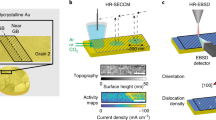Abstract
New aspects characterizing the disruption process are discussed, based on an analysis of a proposed disruption model and on a review of previously reported voltammetric and galvanostatic anodic growths of films on metals and their consequent reduction. For voltammetric cases of Pb and Zn, it is shown that the formation charge is not always recoverable, leading to irreversible processes. The total formation charge of Zn can never be totally recovered, but that of Pb is totally recoverable if the reduction rate trends to zero, rendering the process reversible. Furthermore, disruption always causes part of the film to remain adhered to the metal, which is why it is only partially disrupted. Increasing the reduction rate causes the disruption process to increase and the remaining film adhered to the metal to trend toward a minimum constant value, which differs in Pb and Zn but is equal in voltammetric and galvanostatic experiments with Pb. The conclusions are the same with regard to the galvanostatic results for Pb, except that the film charge density is always totally reversibly recovered if the reduction rate is lower than the formation rate. Moreover, the reduction rate does not necessarily have to trend to zero in this case. It needs only to be lower than or equal to the formation rate. All these facts are discussed based on the disruption model. The paper also discusses in detail how to experimentally obtain highly reproducible measurements, which are fundamental for the conclusion’s validity. These experimental discussions and propositions are also based on the disruption model. High reproducibility is achieved even in the case of Pb, a metal whose reproducibility is notoriously difficult.









Similar content being viewed by others
References
D’Alkaine CV, Pratta PMP (2006) Electrochemical data about disruption of passivating films. The Pb/pbso4/H2SO4 system. In: Marcus P, Maurice V (eds) Passivation of metals and semiconductors and properties of thin oxide layers. Elsevier, Amsterdam, pp 161–166
Sato N, Okamoto G (1981) Electrochemical passivation of metals. In: Bockris JO’M, Conway BE, Yeager, EB, White RE (eds) Comprehensive treatise of electrochemistry, vol 4. Plenum, New York, pp 193–245
D’Alkaine CV (2002) Passivity and dynamic systems. In: CD-ROM of the International Corrosion Congress. Frontiers in corrosion science and technology. Plenary lecture. International Corrosion Council, Granada
Albani OA, Zerbino JO, Vilche JR, Arvia AJ (1986) Electrochim Acta 31:1403–1411
Scully JC (1965) The fundamentals of corrosion. Pergamon, London
D’Alkaine CV, Souza LMM, Nart FC (1993) Corros Sci 34:129–149
D’Alkaine CV, Santanna MA (1998) J Electroanal Chem 457:13–21
D’Alkaine CV, Tulio PC, Berton MAC (2004) Electrochim Acta 49:1989–1997
D’Alkaine CV, Berton MAC, Tulio PC (2003) Port Electrochim Acta 21:15–32
D’Alkaine CV, Tulio PC, Brito GAO, Salvador JÁ (2002) J Braz Chem Soc 13:535–539
Acknowledgements
F.P.F and P.M.P.P. would like to thank Coordenação de Aperfeiçoamento de Pessoal de Nível Superior and Conselho Nacional de Desenvolvimento Científico e Tecnológico, respectively, for their scholarships, which have made possible some parts of the present work.
Author information
Authors and Affiliations
Corresponding author
Additional information
This paper is dedicated to Professor Francisco Carlos Nart, in memoriam.
Rights and permissions
About this article
Cite this article
D’Alkaine, C.V., Garcia, C.M., Brito, G.A.O. et al. Disruption processes in films grown and reduced electrochemically on metals. J Solid State Electrochem 11, 1575–1583 (2007). https://doi.org/10.1007/s10008-007-0361-x
Received:
Revised:
Accepted:
Published:
Issue Date:
DOI: https://doi.org/10.1007/s10008-007-0361-x




